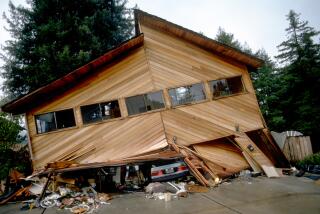They’re floored by all the gaps and cracks
- Share via
Question: We had some floor joists replaced due to water damage and termites. Now, our back door won’t open, and we are having trouble opening and shutting our bathroom door. There are cracks on walls, cracks in the tile on the utility room floor and gaps starting to open between the boards of our hardwood floors. Is the house shifting due to the joist replacements?
Answer: It’s true that improvements in one part of a house can affect the rest of the structure. The pounding during window installation, for instance, can crack stucco. And if those windows “tighten up” the house, as they should, the ventilation may need upgrading.
A reader recently wrote to say that his girlfriend had trouble breathing after his roof was replaced. He suspects some toxin in the attic may have been vibrated loose from the pounding of workers and their hammers.
I naturally suspected, as you did, that the work done on your joists somehow threw off the foundation and brought about the new problems.
But when I asked general contractor Alon Toker, president of Mega Builders (www.megabuilders.com) in Chatsworth, he said: “I have a feeling it’s all water-related.”
Contractor’s answer: Just based on the letter, without having seen the home, these sound to me like symptoms of extensive water damage.
If the floor joists were damaged by water, that probably took a long time to happen, perhaps from a leaking pipe beneath the house. It’s likely the plywood or oriented strand board subfloor also got saturated and has swelled up. This could cause cracked floor tiles. A wet subfloor could be bringing water into the door jambs, making them swell and making the doors hard to open and close. It also could cause the hardwood floorboards to cup or curl, and this would give the appearance of the boards separating.
Call in a remediation company to measure the moisture in the subfloor and under the house. You will also want to get an assessment of the amount of mold present. The solution could be as simple as venting the crawl space and using big fans to dry out the subfloor.
To prevent moisture problems in the first place, here are some tips:
* Don’t try to save money on the water tube going to the ice maker. Unfortunately, these are notorious for failing, especially when the homeowners have installed cheap plastic tubing from the hardware store. A better bet is to hire a plumber to install copper tubing to run the waterline for your ice maker.
* Never run a dishwasher or clothes washer when you’re not home. If a water hose fails, water could be pouring onto the floors for hours. This could give you an excuse for a massive remodel, but that’s probably not the impetus you want.
* If you are putting in a dishwasher, opt for a pan underneath to catch drips and then channel the water outside via a small tube. Often, when an old dishwasher is removed during a kitchen remodel, mold is discovered on the wall. The dark, closed-in wall behind a dishwasher is ideal for such growth.
* When storing supplies under a sink, take care not to knock and push things against the drainpipe. Over time, the jostling under the sink will compromise the watertight seal and the pipes will start to sweat and then to leak. Every month or so, place a paper towel on the floor of the under-sink cabinet to see if there is a leak. A musty smell under the sink indicates mold. Check for leaks and have them fixed.
In general, the amount of money spent preventing water leaks is peanuts compared with the cost of fixing the damage they can cause.
*
Submit remodeling questions to Kathy Price-Robinson at www.kathyprice.com, or to Editor, Real Estate Section, Los Angeles Times, 202 W. 1st St., Los Angeles, CA 90012.


